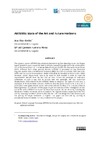Identificador persistente para citar o vincular este elemento:
https://accedacris.ulpgc.es/jspui/handle/10553/70369
| Campo DC | Valor | idioma |
|---|---|---|
| dc.contributor.author | Díaz Galán, Ana | en_US |
| dc.contributor.author | Fumero Pérez, María del Carmen | en_US |
| dc.date.accessioned | 2020-02-19T15:29:00Z | - |
| dc.date.available | 2020-02-19T15:29:00Z | - |
| dc.date.issued | 2017 | en_US |
| dc.identifier.issn | 1133-1127 | en_US |
| dc.identifier.uri | https://accedacris.ulpgc.es/handle/10553/70369 | - |
| dc.description.abstract | The syntactic parser ARTEMIS (Automatically Representing Text Meaning via an Interlingua-based System) is a prototype intended to process natural language within the environment of the Functional Grammar Knowledge Base (FunGramKB) (Periñán-Pascual & Arcas-Túnez, 2010). Different from other parsing devices, ARTEMIS is grounded on two functional linguistic models: Role and Reference Grammar (RRG) (Van Valin & La Polla, 1997; Van Valin, 2005) and the Lexical Constructional Model (LCM) (Ruiz de Mendoza & Mairal Usón, 2008). However, certain adjustments have to be made to both models in order to meet the requirements derived from the fact that ARTEMIS follows the paradigm of Unification Grammars, in such a way that to comply with this paradigm, the GDE (Grammar Development Environment) within ARTEMIS needs to integrate two types of constructs: a catalogue of Attribute-Value Matrixes (AVMs) to describe grammatical units, and a set of production rules (grammatical, lexical and constructional) to allow it to produce a feature based grammar. It is the aim of this paper to give an overview of the investigation carried out so far within ARTEMIS in relation to these two aspects. We will do so by revisiting the literature in relation to the adjustments made to the linguistic models, especially to the RRG, and by reviewing the efforts made to describe the units and design the rules necessary for the parsing of simple sentences in English. Our paper will conclude by pointing at prospective research needed for the completion of this project. | en_US |
| dc.language | eng | en_US |
| dc.relation.ispartof | LFE. Revista de Lenguas para Fines Específicos | en_US |
| dc.source | LFE. Revista de lenguas para fines específicos [eISSN 2340-8561], v. 23 (2), p. 16-40 | en_US |
| dc.subject | 570107 Lengua y literatura | en_US |
| dc.subject | 550510 Filología | en_US |
| dc.subject.other | Natural Language Processing | en_US |
| dc.subject.other | ARTEMIS | en_US |
| dc.subject.other | FunGramKB | en_US |
| dc.subject.other | Computational grammar | en_US |
| dc.subject.other | Role and Reference Grammar | en_US |
| dc.title | ARTEMIS: State of the Art and Future Horizons | en_US |
| dc.type | info:eu-repo/semantics/article | en_US |
| dc.type | Article | en_US |
| dc.identifier.doi | 10.20420/rlfe.2017.171 | en_US |
| dc.investigacion | Artes y Humanidades | en_US |
| dc.type2 | Artículo | en_US |
| dc.identifier.ulpgc | Sí | es |
| dc.description.esci | ESCI | |
| dc.description.dialnetimpact | 0,0 | |
| dc.description.dialnetq | Q3 | |
| dc.description.dialnetd | D6 | |
| dc.description.erihplus | ERIH PLUS | |
| item.fulltext | Con texto completo | - |
| item.grantfulltext | open | - |
| Colección: | Artículos | |
Los elementos en ULPGC accedaCRIS están protegidos por derechos de autor con todos los derechos reservados, a menos que se indique lo contrario.
